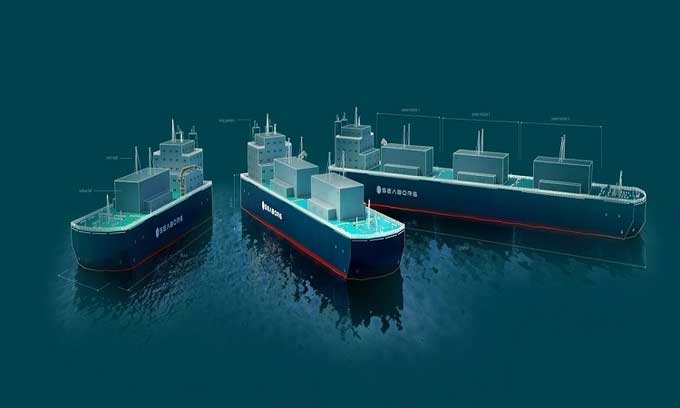Floating nuclear reactor using molten salt
Copenhagen-based start-up Seaborg Technologies is working on a new type of nuclear reactor that is cheap, mobile, flexible and super safe.
With the size of a container, the small molten salt reactor can be mass-produced in thousands of units, then placed on floating barges and deployed around the world.

Each reactor can produce up to 200 MW of electricity and is mounted on floating barges. (Photo: Seaborg Technologies).
Like other molten salt reactors that have existed since the 1950s, Seaborg Technologies' products are designed to minimize the impact of accidents. First, the furnace uses nuclear fuel mixed with fluorine salts . The mixture turns to liquid above 500 degrees Celsius, allowing it to flow through a reactor operating at pressures close to atmospheric pressure. The liquid salt acts as a coolant for nuclear fuel, replacing the high-pressure water cooling in older reactor designs. But if this fuel is exposed to air instead of escaping as steam, it behaves like lava and hardens into rock.
The rock discharged from the furnace is radioactive, but can be cleaned up. It also has low solubility in water so it is quite safe if dropped into the sea. Second, if the temperature spirals out of control for some reason, the hardened salt plug at the bottom of the reactor is the first to melt, immediately dumping the core into the series of cooling tanks below.
But perhaps the most dramatic difference in Seaborg's design is mounting the reactor on a barge floating offshore rather than developing a nuclear power plant on land. The first advantage is the ability to mass produce reactors in one facility. Barges can travel anywhere on the planet, anchor offshore or operate on rivers large or small, depending on the size of the reactor, so there is no need to prepare the ground. The system also operates completely independently and is easily connected to the power grid.
The challenge with all molten salt reactors is erosion. The molten salt itself is very corrosive. This would be a major challenge in designing every component exposed to fuel salts. Placing the furnace on a barge floating in sea water also exposes the outer layer of the furnace to corrosive agents. Cargo ships are usually designed to last 25 years due to the influence of sea water.
Other molten salt reactors use graphite as a moderator, slowing the rate of neutrons produced by fission. However, graphite often cracks and weakens when exposed to intense radiation and repeated heating and cooling. Seaborg's solution was to use another molten salt, sodium hydroxide, as a moderator. The fuel salt tube is placed inside the larger sodium hydroxide tube, creating a nuclear reactor that uses all liquid fuel. But sodium hydroxide itself is also extremely corrosive, so Seaborg needs to deal with this as well.
The large prototype of the molten salt reactor is expected to be operational by 2025 off an island in Southeast Asia. Seaborg hopes to be able to apply for a design license by 2026 and mass-produce it on a commercial scale by 2027. Seaborg's reactor is small enough to fit in a container, so it's easy to transport, and will run for about 12 years without needing to worry. no refueling required.
- Detecting a molten nuclear fuel at Fukushima
- NASA: Mars nuclear reactor was successfully tested
- Russia's floating nuclear power plant is ready to conquer the Arctic
- The young and ambitious female engineer created carbon-free electricity
- Conceptual design of large plutonium nuclear reactor
- US printed 3D nuclear reactor core
- There was once a nuclear reactor flying above our heads
- 13 years old to build a nuclear reactor
- Successfully built Stellarator-type thermonuclear reactor
- Technology can provide enough energy for humans for billions of years
- Mysterious uranium from Hitler's nuclear reactor
- NASA successfully tested Mars's nuclear reactor
 Norway built the world's tallest wooden tower
Norway built the world's tallest wooden tower Kremlin
Kremlin Ashurbanipal: The oldest royal library in the world
Ashurbanipal: The oldest royal library in the world Decoding the thousand-year construction of Qin Shihuang shocked the world
Decoding the thousand-year construction of Qin Shihuang shocked the world